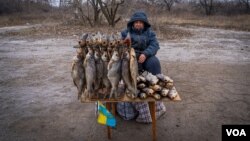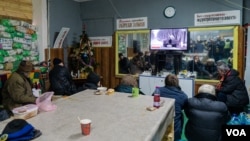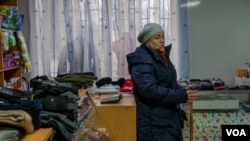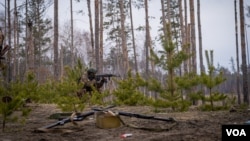Serhi Zamulenko, 49, used to sell fish in the Chasiv Yar market. But when the war drew closer, he moved his small stand to a roadside just outside of town.
The battle is now fewer than 10 kilometers away from this town, and the banging of artillery can be heard day and night from both sides. Shells have fallen next to Zamulenko’s fish stand numerous times, the last one this past Thursday.
“Of course I’m scared here,” he tells us. “But where else can I go?” He then insists we accept his gift of a smoked fish that he cured for five days.
Like many in the Donbas region of eastern Ukraine, Zamulenko sees staying home, when most of the people fled long ago, as an act of patriotism.
“I stay here because this is my land,” Zamulenko says. “I belong here. This is no place for Russians.”
Bakhmut bunker
Besides defiance, another common refrain in Donbas is despair. Many people who stayed in the war zones were already poor, elderly or infirm. Now, they are destitute. Gone are jobs, reliable electricity, water and heat, along with many of the buildings and people.
“Where should I go?” asks Lyudmyla Malynovska, 52, from a public bunker in Bakhmut, a city that for the past six months has seen fierce fighting in Russia’s war in Ukraine. “Nobody needs me,” she says.
Malynovska appears stoic when she speaks about physical hardship but breaks down in tears when talking about hope. The only thing she dreams of, she says, is an end to this war.
“We don’t really know what is happening because we can’t check online,” she explains, brushing away tears.
The short walk to the bunker could have been deadly, but she came here for company and a little bit of news.
The bunker also supplies food and water. Aid workers are building showers for people whose water supply has been destroyed. Many Bakhmut residents have been without a water supply for months.
Bakhmut is about two kilometers away from where Ukrainian soldiers face off with Russians, close enough to shoot each other with guns. Artillery and other weapons enter every part of the city, and the locals tell us the cacophony quiets for a maximum of 10 minutes a day.
“We can only experience it,” Malynovska says. “The front line is on fire.”
The sound of war
Like other towns here in Donbas, Chasiv Yar is situated near the front lines and between the opposing armies. The war is in close enough quarters that incoming and outgoing fire sound almost the same: loud bangs followed a few seconds later by boom booms.
The initial blast of an outgoing weapon is louder than incoming fire, but it is shot from only a little bit farther away. Sometimes, artillery can be heard overhead, as shells travel in the direction of an opposing army. All too often, they fall in the city, destroying lives and livelihoods in a tragic moment.
Only a few days ago, bombs destroyed several homes in Chasiv Yar, says Lubov Bilous, 59, a shopkeeper who sells military-style hats, gloves and long underwear to soldiers from her store, which once exclusively carried children’s toys. On the same day, about four people died, say other residents.
“Even the children here know the difference between the sounds of incoming and outgoing fire,” she says.
About an hour away from Bakhmut but still fewer than 20 kilometers from battle, Yuriy Shpak, 54, dismisses the constant rumble of bombs surrounding his town, Lyman, which is almost deserted.
“Yes, the bombs fell in the garden. But our metal doors did their jobs, and I lived.”
Then, the ever-present sound of artillery fire is interrupted by heavy, sustained gunfire. We later learn the gunfire is from a training ground where troops pummel a metal barrel close enough to the front lines to hear the weapons intended to kill them.
None of this fazes Shpak, who tells us that this day with its noises is not bothersome compared to the days of real violence, when bombs rained down on the town as Ukraine wrested Lyman back from Russia. Or more recently, the day when a 4-year-old girl was killed when a bomb crashed into the playground next door.
Shpak spends his days covering windows with boards, plastic and chopping wood to keep the few people remaining in town a little bit warm. On many nights, his wife sleeps in the basement, afraid of the noise.
“I tried to get her to leave,” Shpak tells us. “But she won’t. She says, ‘I won’t go anywhere without you.’”
We ask if he will finally leave if the situation becomes much worse. He laughs.
“How much worse could it get?” he said.
Old war, new feelings
Snow falls on Zamulenko’s fish stand as he flexes a bicep muscle, joking that if he is strong enough to survive the war, he can stay outside all day in the cold.
On his rack of fish, he flies a small Ukrainian flag, a symbol that is not without controversy this close to the front lines. Most people in the region speak Russian as opposed to Ukrainian, and some, we are told, support the idea of Russian rule, if not the invasion itself.
Zamulenko and other staunch supporters of Ukrainian rule call this a hope for “Russian peace,” a term they use ironically, meaning endless war and destruction.
For the people in Donbas, the war did not begin with the Russian invasion in February 2022. It has been ongoing since 2014, when a mass protest movement helped replace the Kremlin-backed government with pro-Western leadership. Russia then took the Crimean Peninsula, and a Russia-backed separatist movement sprung up. Nearly 15,000 people have died in the fighting.
Zamulenko says the past year of fighting has solidified his identity as a Ukrainian patriot and his resolve to stay home, no matter how dangerous the situation becomes.
“If you stay a little while longer, you may see for yourself,” Zamulenko tells us, pointing to a clearing in the woods a few meters away.
“Just four days ago, a shell fell right over there,” he says.





